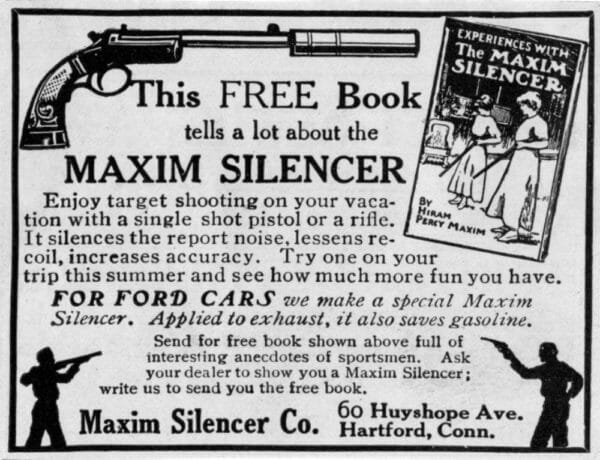A close friend told me of a high school field trip he went on in 1975. The trip was to a slaughterhouse in Sioux Falls, South Dakota. There, he encountered a Maxim Silencer attached to a .22 single-shot pistol. The Maxim and pistol were displayed on the wall. The display said the silenced pistol had been used to slaughter over two million cattle before it was retired, presumably when a captive bolt system was substituted.
Research revealed Sioux Falls was close to where my friend went to school. It has a huge slaughterhouse industry, started in 1909. The number of animals processed there each year numbers in the millions. By 1949, 800 cattle were being processed there each day. According to a source online, it takes about two minutes to move an animal on the processing line. If we limit a day to eight hours, there would be 240 cattle processed in a day. If we limit the days used in a year to 200, there would be 48,000 cattle processed in a year, and it would take 42 years to process 2 million cattle. The plant was started in 1909, the same year the Maxim Silencer became available. There was enough time for the Maxim system to be used for 2 million heads of cattle.
As a practical matter, the plant operates 24/7 in shifts, 365 days a year, so there was enough time to process millions of heads on several different lines, including time used for regular maintenance.
Another friend, Don Cowling, was involved in research at the University of Wisconsin, Madison, which included retrieving cattle organs and blood from freshly killed animals. He reported the use of a .22 single shot in the slaughterhouse in the 1960's. That .22 did not have a Maxim Silencer.
In 2002, Al Paulson, in Smallarmsreview.com, reported the use of a single-shot .22 pistol with a Maxim Silencer in a Texas slaughterhouse from 1909 to 2000. Paulson calculated the number of cattle processed with the combination to be over 700,000 during the 91-year period. He wrote the combination was in excellent condition, although the finish had worn off the silencer. He tested the silencer, a Maxim Model 1909. It reduced the sound signature by 33 decibels, a good performance for a modern model. The Texas Maxim had an appropriate IRS number, showing it had been registered as required by the National Firearms Act.
In a 2011 Small Arms Review follow-up article, Mark White revealed more information about the Texas slaughterhouse Maxim and pistol. The pistol appears to have been a converted Quackenbush Bicycle rifle threaded for the Maxim.

Paulson said the barrel length was just under seven inches. The Maxim models were sealed units. Flushing them with hot, soapy water, draining, drying, and then oiling them was the recommended maintenance. From the article:
Highly corrosive materials in the priming and propellant gas required that a Maxim silencer be removed and boiled in soapy water after each and every use. It then had to be drained, dried and re-oiled to prevent destructive corrosion. Most of the early Maxim silencers have been ruined over the years because they lacked this high level of care.
Hot water and soap are not difficult to find in a slaughterhouse. After 1934, a Maxim setup became 20 times as valuable. To obtain one after 1934 required a $200 tax stamp. Many items that existed before the National Firearms Act was passed were grandfathered in during a 60-day grace period without paying the tax. Maxim stopped manufacture of the 1909 model by 1930, if not earlier, so a replacement might have been difficult to find. Maxim silencers kept animals coming up the line from becoming agitated. They protected workers' hearing. They were an effective industrial tool for decades of American history.
My friend thought the Maxim in Sioux Falls was mounted on a Stevens single shot with a break-open action, as shown in the Maxim ad.
Both Quackenbush and Stevens designs are simple and rugged. They do not spew brass in an industrial area. Two minutes is plenty of time to load a single-shot pistol. The designers of the firearms and Hiram Percy Maxim, designer of the silencer (son of the designer of the Maxim machine gun), built robust machines that performed well for hundreds of thousands to millions of operations over several decades.


